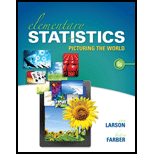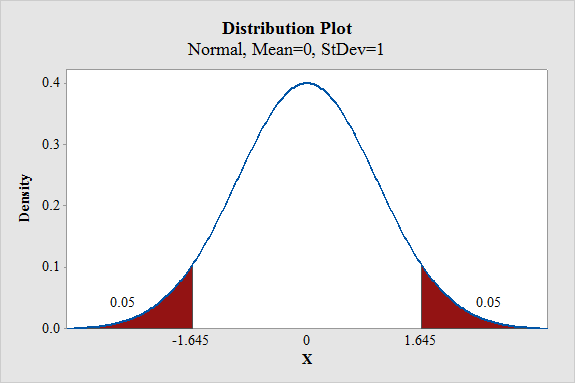
Concept explainers
The waking times (in minutes past 5:00 A.M.) of 40 people who start work at 8:00 A.M. are shown in the table at the left. Assume the population standard deviation is 45 minutes. Find (a) the point estimate of the population
(a)
To find: The point estimate for the mean
Answer to Problem 6.1.1RE
The point estimate for the mean
Explanation of Solution
Given info:
The data shows that the waking times of 40 people who start work at 8:00 A.M.
Calculation:
Point estimate:
The point estimate of the population mean
Software Procedure:
Step by step procedure to obtain the sample mean using the MINITAB software:
- Choose Stat > Basic Statistics > Display Descriptive Statistics.
- In Variables enter the columns Waking times (in minutes past 5).
- In Statistics choose mean.
- Click OK.
Output using the MINITAB software is given below:

From the MINITAB output, the point estimate for the mean waking time is 103.5 minutes.
(b)
To find: The margin of error.
Answer to Problem 6.1.1RE
The margin of error is 11.70.
Explanation of Solution
Given info:
Calculation:
Critical value:
Software procedure:
Step by step procedure to obtain the P-value using the MINITAB software:
- Choose Graph > Probability Distribution Plot choose View Probability > OK.
- From Distribution, choose ‘Normal’ distribution.
- Click the Shaded Area tab.
- Choose Probability Value and Both Tail for the region of the curve to shade.
- Enter the Probability value as 0.10.
- Click OK.
Output using the MINITAB software is given below:

From the output, the critical value
Margin of error:
The formula for the margin of error is,
Substitute 1.645 for
Thus, the margin of error is 11.70.
Want to see more full solutions like this?
Chapter 6 Solutions
Elementary Statistics: Picturing the World (6th Edition)
- A company manages an electronic equipment store and has ordered 200200 LCD TVs for a special sale. The list price for each TV is $200200 with a trade discount series of 6 divided by 10 divided by 2.6/10/2. Find the net price of the order by using the net decimal equivalent.arrow_forwardAccording to flightstats.com, American Airlines flights from Dallas to Chicago are on time 80% of the time. Suppose 10 flights are randomly selected, and the number of on-time flights is recorded. (a) Explain why this is a binomial experiment. (b) Determine the values of n and p. (c) Find and interpret the probability that exactly 6 flights are on time. (d) Find and interpret the probability that fewer than 6 flights are on time. (e) Find and interpret the probability that at least 6 flights are on time. (f) Find and interpret the probability that between 4 and 6 flights, inclusive, are on time.arrow_forwardShow how you get critical values of 1.65, -1.65, and $1.96 for a right-tailed, left- tailed, and two-tailed hypothesis test (use a = 0.05 and assume a large sample size).arrow_forward
- Suppose that a sports reporter claims the average football game lasts 3 hours, and you believe it's more than that. Your random sample of 35 games has an average time of 3.25 hours. Assume that the population standard deviation is 1 hour. Use a = 0.05. What do you conclude?arrow_forwardSuppose that a pizza place claims its average pizza delivery time is 30 minutes, but you believe it takes longer than that. Your sample of 10 pizzas has an average delivery time of 40 minutes. Assume that the population standard deviation is 15 minutes and the times have a normal distribution. Use a = 0.05. a. What are your null and alternative hypotheses? b. What is the critical value? c. What is the test statistic? d. What is the conclusion?arrow_forwardTable 5: Measurement Data for Question 9 Part Number Op-1, M-1 Op-1, M-2 | Op-2, M-1 Op-2, M-2 | Op-3, M-1 Op-3, M-2 1 21 20 20 20 19 21 2 24 23 24 24 23 24 3 4 5 6 7 8 9 10 11 21 12 8222332 201 21 20 22 20 22 27 27 28 26 27 28 19 18 19 21 24 21 22 19 17 18 24 23 25 25 23 26 20 20 18 19 17 13 23 25 25 2 3 3 3 3 2 3 18 18 21 21 23 22 24 22 20 19 23 24 25 24 20 21 19 18 25 25 14 24 24 23 25 24 15 29 30 30 28 31 16 26 26 25 26 25 17 20 20 19 20 20 843882388 20 18 25 20 19 25 25 30 27 20 18 19 21 19 19 21 23 19 25 26 25 24 25 25 20 19 19 18 17 19 17 Question 9 A measurement systems experiment involving 20 parts, three operators (Op-1, Op-2, Op-3), and two measure- ments (M-1, M-2) per part is shown in Table 5. (a) Estimate the repeatability and reproducibility of the gauge. (b) What is the estimate of total gauge variability?" (c) If the product specifications are at LSL = 6 and USL 60, what can you say about gauge capability?arrow_forward
- Question 5 A fraction nonconforming control chart with center line 0.10, UCL = 0.19, and LCL = 0.01 is used to control a process. (a) If three-sigma limits are used, find the sample size for the control charte 2 (b) Use the Poisson approximation to the binomial to find the probability of type I error. (c) Use the Poisson approximation to the binomial to find the probability of type II error if the process fraction defective is actually p = 0.20.arrow_forwardQuestion 8 Ten parts are measured three times by the same operator in a gauge capability study. The data are shown in Table 4. (a) Describe the measurement error that results from the use of this gauge. I (b) Estimate total variability and product variability. (c) What percentage of total variability is due to the gauge? (d) If specifications on the part are at 100±15, find the P/T ratio for this gauge. Comment on the adequacy of the gauge. 3 Table 4: Measurement Data for Question 8 Part Number Measurement 1 Measurement 2 Measurement 3 1 2 100 95 101 100 93 97 3 101 103 100 4 96 95 97 5 98 98 96 6 99 98 98 7889 95 97 98 100 99 98 100 100 97 10 100 98 98 99arrow_forwardQuestion 6 The data shown in Table 3 are and R values for 24 samples of size n = 5 taken from a process producing bearings. The measurements are made on the inside diameter of the bearing, with only the last three decimals recorded (i.e., 34.5 should be 0.50345). Perform a process capability analysis using and R charts for the data from Table 3. Table 3: Data for Question 6 Sample Number R | Sample Number I Ꭱ 1 34.5 3 13 35.4 8 2 34.2 4 14 34.0 6 ∞∞ 31.6 15 37.1 5 4 31.5 4 16 34.9 7 56789 35.0 5 17 33.5 4 34.1 6 18 31.7 3 32.6 4 19 34.0 8 33.8 3 20 35.1 4 34.8 7 10 33.6 8 11 31.9 3 12 38.6 9 2232 21 33.7 2 32.8 1 33.5 24 34.2 2 32 3arrow_forward
- Question 1 The commercial loan operation of a financial institution has a standard for processing new loan applications in 24 hours. Table 1 shows the number of applications processed each day for the last 20 days and the number of applications that required more than 24 hours to complete. Table 1: Loan Application Data for Question 1 Day Applications Late Day Applications Late 1 200 3 11 219 0 2 250 4 12 238 10 3 240 2 13 250 4 4 300 5 14 302 6 5 200 2 15 219 20 6 250 4 16 246 3 7 246 3 17 251 6 8 258 5 18 273 7 9 275 2 19 245 3 10 274 1 20 260 (a) Set up the fraction nonconforming control chart for this process. Use the variable-width control limit approach. Plot the preliminary data in Table 1 on the chart. Is the process in statistical control? (b) Assume that assignable causes can be found for any out-of-control points on this chart. What center line should be used for process monitoring in the next period, and how should the control limits be calculated?arrow_forwardhelp me with ab please. please handwrite if possible. please don't use AI tools to answerarrow_forwardhelp me with ab please. please handwrite if possible. please don't use AI tools to answerarrow_forward
 Glencoe Algebra 1, Student Edition, 9780079039897...AlgebraISBN:9780079039897Author:CarterPublisher:McGraw Hill
Glencoe Algebra 1, Student Edition, 9780079039897...AlgebraISBN:9780079039897Author:CarterPublisher:McGraw Hill Big Ideas Math A Bridge To Success Algebra 1: Stu...AlgebraISBN:9781680331141Author:HOUGHTON MIFFLIN HARCOURTPublisher:Houghton Mifflin Harcourt
Big Ideas Math A Bridge To Success Algebra 1: Stu...AlgebraISBN:9781680331141Author:HOUGHTON MIFFLIN HARCOURTPublisher:Houghton Mifflin Harcourt

